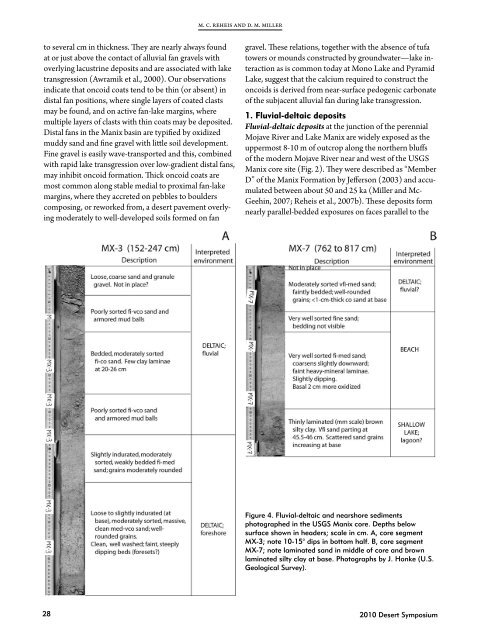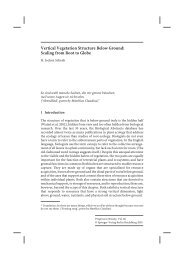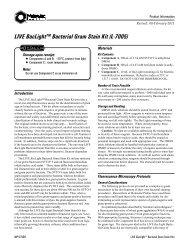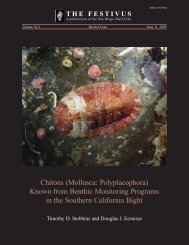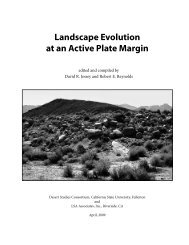- Page 1 and 2: Overboard in the Mojave 20 million
- Page 3 and 4: 2010 Desert Symposium Table of cont
- Page 5 and 6: Aerial surveys using consumer elect
- Page 7 and 8: Overboard in the Mojave: the field
- Page 9 and 10: to distinctive lake beds indicates
- Page 11 and 12: the south during the early Miocene.
- Page 13 and 14: Atlantic and Pacific Railroad at Wa
- Page 15 and 16: 8.5 (0.2) Continue past Big Borate
- Page 17 and 18: Stop M-10. Owl Canyon Campground-Sp
- Page 19 and 20: 0.0 (0.3) Continue past Armory Road
- Page 21 and 22: deposits (Vitrlite deposits); if th
- Page 23 and 24: Meek, Norman. 2000. The late Wiscon
- Page 25 and 26: environments of nearshore lacustrin
- Page 27: 2010 Desert Symposium environments
- Page 31 and 32: 2010 Desert Symposium environments
- Page 33 and 34: environments of nearshore lacustrin
- Page 35 and 36: 2010 Desert Symposium environments
- Page 37 and 38: environments of nearshore lacustrin
- Page 39 and 40: stratigraphy and paleontology of th
- Page 41 and 42: stratigraphy and paleontology of th
- Page 43 and 44: stratigraphy and paleontology of th
- Page 45 and 46: 2010 Desert Symposium stratigraphy
- Page 47 and 48: 2010 Desert Symposium stratigraphy
- Page 49 and 50: stratigraphy and paleontology of th
- Page 51 and 52: stratigraphy and paleontology of th
- Page 53 and 54: stratigraphy and paleontology of th
- Page 55 and 56: stratigraphy and paleontology of th
- Page 57 and 58: 2010 Desert Symposium An interview
- Page 59 and 60: the fall and it wasn’t very warm
- Page 61 and 62: an interview with elmer ellsworth F
- Page 63 and 64: the season, and he had housing ther
- Page 65 and 66: Acknowledgments I would like to tha
- Page 67 and 68: Yermo Hills) gravels have a norther
- Page 69 and 70: Along Interstate 15, compiled by R.
- Page 71 and 72: econnaissance geochronology of tuff
- Page 73 and 74: 2010 Desert Symposium reconnaissanc
- Page 75 and 76: 2010 Desert Symposium reconnaissanc
- Page 77 and 78: econnaissance geochronology of tuff
- Page 79 and 80:
econnaissance geochronology of tuff
- Page 81 and 82:
econnaissance geochronology of tuff
- Page 83 and 84:
econnaissance geochronology of tuff
- Page 85 and 86:
Stratigraphy, age, and depositional
- Page 87 and 88:
stratigraphy, age, and depositional
- Page 89 and 90:
2010 Desert Symposium stratigraphy,
- Page 91 and 92:
stratigraphy, age, and depositional
- Page 93 and 94:
stratigraphy, age, and depositional
- Page 95 and 96:
stratigraphy, age, and depositional
- Page 97 and 98:
2010 Desert Symposium stratigraphy,
- Page 99 and 100:
stratigraphy, age, and depositional
- Page 101 and 102:
stratigraphy, age, and depositional
- Page 103 and 104:
stratigraphy, age, and depositional
- Page 105 and 106:
Correlation of the Miocene Peach Sp
- Page 107 and 108:
correlation of the miocene peach sp
- Page 109 and 110:
2010 Desert Symposium correlation o
- Page 111 and 112:
Table 1 continued 2010 Desert Sympo
- Page 113 and 114:
2010 Desert Symposium correlation o
- Page 115 and 116:
correlation of the miocene peach sp
- Page 117 and 118:
correlation of the miocene peach sp
- Page 119 and 120:
2010 Desert Symposium correlation o
- Page 121 and 122:
correlation of the miocene peach sp
- Page 123 and 124:
While in Barstow, Buwalda stayed in
- Page 125 and 126:
mammalian litho- and biochronology
- Page 127 and 128:
mammalian litho- and biochronology
- Page 129 and 130:
2010 Desert Symposium mammalian lit
- Page 131 and 132:
mammalian litho- and biochronology
- Page 133 and 134:
mammalian litho- and biochronology
- Page 135 and 136:
mammalian litho- and biochronology
- Page 137 and 138:
2010 Desert Symposium mammalian lit
- Page 139 and 140:
mammalian litho- and biochronology
- Page 141 and 142:
mammalian litho- and biochronology
- Page 143 and 144:
mammalian litho- and biochronology
- Page 145 and 146:
mammalian litho- and biochronology
- Page 147 and 148:
mammalian litho- and biochronology
- Page 149 and 150:
Figure 1a. Locality and outcrop ref
- Page 151 and 152:
strontium prospects (Durrell, 1953)
- Page 153 and 154:
Mountains site contains 28% CaCO by
- Page 155 and 156:
Toomey Hills-Yermo Hills (Emerald B
- Page 157 and 158:
14.0 Ma (Pagnac, 2009). The Miocene
- Page 159 and 160:
Dokka, R.K. and C.J. Travis. 1990.
- Page 161 and 162:
Lister, K. H., 1970, Paleoecology o
- Page 163 and 164:
miocene and late pleistocene stickl
- Page 165 and 166:
miocene and late pleistocene stickl
- Page 167 and 168:
miocene and late pleistocene stickl
- Page 169 and 170:
75 years of fieldwork in the Barsto
- Page 171 and 172:
75 years of fieldwork in the barsto
- Page 173 and 174:
75 years of fieldwork in the barsto
- Page 175 and 176:
75 years of fieldwork in the barsto
- Page 177 and 178:
Paleomagnetism of Miocene volcanic
- Page 179 and 180:
paleomagnetism of miocene volcanic
- Page 181 and 182:
paleomagnetism of miocene volcanic
- Page 183 and 184:
paleomagnetism of miocene volcanic
- Page 185 and 186:
paleomagnetism of miocene volcanic
- Page 187 and 188:
paleomagnetism of miocene volcanic
- Page 189 and 190:
paleomagnetism of miocene volcanic
- Page 191 and 192:
paleomagnetism of miocene volcanic
- Page 193 and 194:
paleomagnetism of miocene volcanic
- Page 195 and 196:
paleomagnetism of miocene volcanic
- Page 197 and 198:
nite and monzodiorite while the met
- Page 199 and 200:
geology and tectonic development of
- Page 201 and 202:
geology and tectonic development of
- Page 203 and 204:
Basalt is present east of the axis
- Page 205 and 206:
Schermer, E.R., Luyendyk, B.K., and
- Page 207 and 208:
2010 Desert Symposium camel tracks
- Page 209 and 210:
The Palm Borate Company operations,
- Page 211 and 212:
Claim Name Section 2010 Desert Symp
- Page 213 and 214:
Geology and ore genesis of epitherm
- Page 215 and 216:
geology and ore genesis of epitherm
- Page 217 and 218:
geology and ore genesis of epitherm
- Page 219 and 220:
geology and ore genesis of epitherm
- Page 221 and 222:
geology and ore genesis of epitherm
- Page 223 and 224:
geology and ore genesis of epitherm
- Page 225 and 226:
Figure 2. Cladoplebis sp. equal len
- Page 227 and 228:
Figure 8. c.f. Adocus sp. ogy to Gl
- Page 229 and 230:
Figure 13. Iguanodont tooth. Figure
- Page 231 and 232:
Hickey, L.J. and Doyle, J.A., 1977,
- Page 233 and 234:
3 are extremely rare. Member 4 is s
- Page 235 and 236:
new marine sites from member 4d of
- Page 237 and 238:
new marine sites from member 4d of
- Page 239 and 240:
Plantae Pieces of fossil wood (some
- Page 241 and 242:
A juvenile specimen of Archaeohippu
- Page 243 and 244:
2010 Desert Symposium a juvenile sp
- Page 245 and 246:
Table III: Lower tooth measurements
- Page 247 and 248:
Pagnac, D. C. 2009. Large mammal bi
- Page 249 and 250:
early pleistocene range extension f
- Page 251 and 252:
2010 Desert Symposium early pleisto
- Page 253 and 254:
The first tungsten-mining boom at A
- Page 255 and 256:
Atolia in 1909. USGS Hess. Their sh
- Page 257 and 258:
them a fine concentrating propositi
- Page 259 and 260:
St. Elmo Dist. etc. What I would li
- Page 261 and 262:
article which was published in the
- Page 263 and 264:
in sight and that after a little fu
- Page 265 and 266:
from this mine.—In drilling for w
- Page 267 and 268:
little over 150 feet and runs about
- Page 269 and 270:
here and now brand as a deliberate
- Page 271 and 272:
[Excerpts:] Thomas McCarthy, the Ra
- Page 273 and 274:
Thermal infrared airborne hyperspec
- Page 275 and 276:
Figure 3. The Calipatria fault (CP)
- Page 277 and 278:
detection of ammonia venting on the
- Page 279 and 280:
Kirkland, L. E., K. C. Herr,, and J
- Page 281 and 282:
serve the full array of sensitive n
- Page 283 and 284:
exposure. The LCROSS experiment was
- Page 285 and 286:
Paleomagnetic and radiocarbon recor
- Page 287 and 288:
contrast, very little information i
- Page 289 and 290:
the fine-grained fluvial sands on t
- Page 291 and 292:
lakes between 25 and ~9.9 cal ka, e


